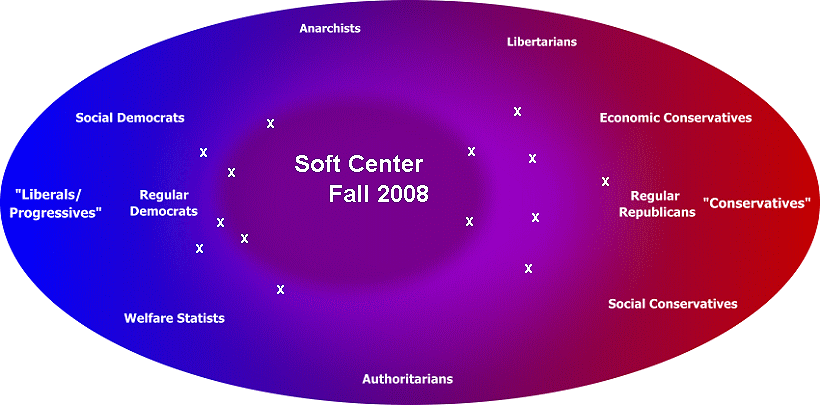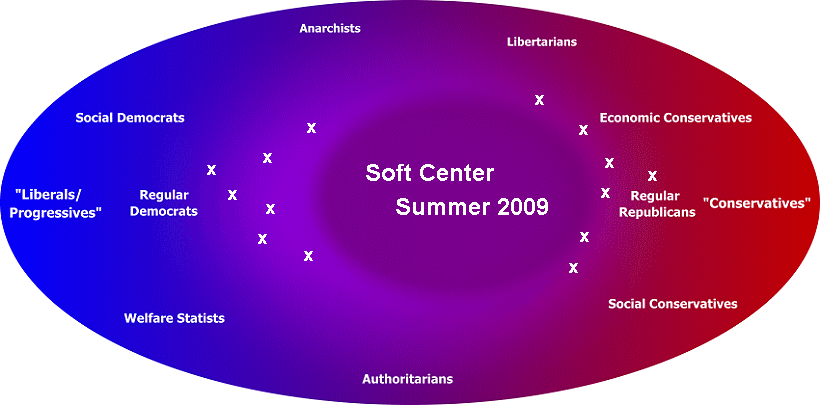The following is a work of literature (in the broadest sense) and not a work of science, social or otherwise:
It must be said at the outset that this hypothesis is based on impressions, which is to say not supported (or contradicted) by data (at this point). The diagrams below are not based on actual demographic information and are not put forward as expressing numbers of people taking particular positions.
The diagrams are meant only to represent relationships among political positions and relative to the position of the "soft center" – that part of the electorate, and those otherwise politically involved that, by the effective use of such factors as fear, anger, and hope, can be moved from right to left, and to some extent "up" and "down" (that is, up toward little or no government or down toward total government).
The hypothesis suggests that influencing the soft center is the main requirement for political success in our present system.
A large soft center that is best influenced by simple appeals (the sort that fit on a bumper sticker), moved by personal popularity, and not tied to any hard political philosophy necessarily seems to encourage partisan attitudes among politicians. Holding the soft center once it has been drawn into a partisan political space demands firm partisan consistency. (Few of us would buy anything important, whether a used car or a political idea, if the people selling it lacked obvious enthusiasm for their product; if they have enough enthusiasm, we're liable to buy even when we don't quite believe everything we're being told.)
Behaviors, not philosophies:
The political positions in the diagrams are meant to reflect political behaviors, not political philosophies. Many of us simultaneously hold ideas generally categorized as both "liberal" and "conservative." And successful American political parties have always been coalitions.[1] But our political system has tended to be binary – modern political campaigns and elections force us to choose one side or the other.
Political behavior takes many forms. Working for a candidate, making a contribution, taking part in political events, voting, and responding to a poll are all political behaviors.
Limits: The hypothesis is not put forward as describing a universal rule of politics. The arrangement suggested by the diagrams is only valid for the American political environment since the conservative takeover of the Republican Party (which may be said to have taken place between the collapse of the Nixon administration and the rise of Ronald Reagan).
It may be, however, that the basic idea – that there is a chronically indecisive mass of potential voters being drawn toward one or another part of the long-term spectrum of politics – is applicable to any more-or-less democratic political system.
Definitions: Those taking the "Liberal/Progressive" position in the diagrams favor mass economic rights (health care as a universal entitlement, for example); social equality in terms of "race," gender, and preferences, and a broad electorate. Those for whom I have appropriated to term "Social Democrats" put a relative emphasis on individual rights and fundamental equality while those labeled "Welfare Statists" favor what has been called "social engineering" and the "nanny state," and thus implicitly favor a hierarchical social structure in which, as Orwell said, some are more equal than others.
Those on the "Conservative" end favor individual and especially elite economic rights, "traditional" hierarchical social arrangements, and a limited electorate. "Economic Conservatives" are more concerned with limiting regulation and maintaining a "free market" system, while "Social Conservatives" are more concerned with maintaining proper social standards as they understand them, usually coupled with a religious belief.
"X" marks the hypothetical positions of politicians, who generally seek to stake out strategic positions in or near the Soft Center.
At present on the right: The conservative coalition has always had the advantage of relative unity in this political alignment. There is no inherent contradiction between economic conservatism and social conservatism.
The conservative coalition also has the advantage of a history of using fear and anger as a political organizing tools. But fear and anger do not always produce predictable political behavior.
Having gained significant power as a result of the November 2010 elections, elected conservatives must now satisfy the hopes of the "Tea Party" neo-populists,[2] who handed the Republicans many of their victories by attracting the soft center to the right. This is a dangerous situation for the Republicans.
Hope fades away far faster than fear and anger. It must be satisfied from time to time to at least to some small degree or it wilts. Fear and anger, on the other hand, grow more powerful with frustration.
The principal appeal to the neo-populists was, and remains, the hope that government spending (and taxes) can be reduced. Given that the Republicans control the House of Representatives, they can send a significantly reduced budget to the Senate and threaten to withhold any funding if the Senate balks.
Should they fail to follow through, the the soft center will become disaffected, just as it became disaffected with the Bush administration. "Tea Party" fear and anger will be turned against the Republican leadership.
Moreover, neo-populist vulnerability to suspicion and resentment of the financial "masters of the universe" could become a source of disaffection. The neo-populist soft center may (or may not) eventually see that the Republican leadership favors the interests of economic elites, even to the point of encouraging raging corporate excesses.
Should the soft center now hovering on the right show signs of disaffection, the firm right-wing coalition may come apart, temporarily, as its component groups scramble to influence the soft center at the expense of one another.
At present on the left: The liberal/progressive coalition is stuck with fragile hope as its main motivator. But the right-wing dash to its own margins may give the left wing a major opening to use fear – the fear that Medicare and Social Security will be gutted by conservatives if they have the chance. The "Tea Party" participants who objected to government interference with Medicare in the run-up to the passage of the health care bill could become bitter opponents of principled small-government conservatives if their government benefits are truly threatened.

There is an inherent contradiction between the wings of the liberal/progressive coalition. The "Social Democratic" concern with fundamental equality and individual rights cannot comfortably co-exist indefinitely with the "Welfare Statist" determination to improve society en masse.
However, fierce conservative and neo-populist opposition to "socialism," equating practically any Democratic initiative with a government takeover, mutes that conflict at present, and so contributes to relative unity on the left.

